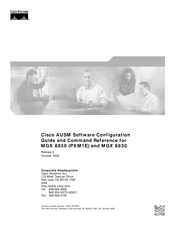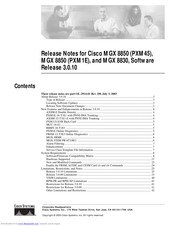Cisco MGX 8830 Manuals
Manuals and User Guides for Cisco MGX 8830. We have 3 Cisco MGX 8830 manuals available for free PDF download: Configuration Manual, Software Configuration Manual And Command Reference, Release Notes
Cisco MGX 8830 Configuration Manual (642 pages)
Multiservice Switch
Brand: Cisco
|
Category: Network Router
|
Size: 7 MB
Table of Contents
-
-
-
-
-
-
Adding Users88
-
-
-
-
-
Setting up Lines150
-
-
-
Adding ATM Ports172
-
-
-
-
-
Where to Go Next251
-
-
Where to Go Next263
-
-
Cisco Scts266
-
Managing Scts268
-
-
-
-
-
-
-
-
Managing Cugs346
-
-
-
-
Managing ILMI371
-
-
-
-
-
-
-
Displaying Svcs407
-
Managing IMA455
-
-
-
Adding Cards462
-
Replacing Cards466
-
-
Appendix
501 -
-
-
-
Appendix
549 -
Appendix
555 -
-
Appendix
571 -
Appendix
575
Advertisement
Cisco MGX 8830 Software Configuration Manual And Command Reference (272 pages)
AUSM Software
Table of Contents
-
-
-
Addcon
84-
Addimagrp89
-
-
Addln
90 -
Clear
103-
Clraimgrpcnt104
-
Clraimlncnt105
-
-
Clralm
106-
Clralmcnt107
-
Clralmcnts108
-
Clralms109
-
Clrcderrs110
-
Clrchancnt111
-
Clrchancnts112
-
Clrimagrpcnt113
-
Clrimalncnt114
-
Clrimatst115
-
Clrmsgcnt116
-
Clrportcnt117
-
Clrportcnts118
-
Clrsarcnt119
-
Clrsarcnts120
-
Clrscrn121
-
Clrslftst122
-
Clrtaskinfo123
-
-
Cls
124-
Cnfaimgrp125
-
Cnfautorestart126
-
Cnfcdprtntype127
-
Cnfcdrscprtn128
-
Cnfchan129
-
Cnfchanq131
-
-
Cnfcon
132-
Cnfconabrparams134
-
Cnfconabrrates136
-
Cnfconstdabr137
-
Cnfilmi139
-
Cnfimaalmparm141
-
Cnfimagrp142
-
Cnfimatst143
-
-
Cnfln
144-
Cnflnloop146
-
Cnfplpp147
-
Cnfportq148
-
Cnfportrscprtn150
-
Cnfrscprtn152
-
Cnfslftst154
-
Cnfupcabr155
-
Cnfupccbr157
-
Cnfupcrtvbr159
-
Cnfupcubr161
-
Cnfupcvbr163
-
Copychans165
-
Delaimgrp166
-
Delcdrscprtn167
-
Delchan168
-
Delchanloop169
-
Delchans170
-
-
Delcon
171-
Delimagrp172
-
-
Delln
173-
Dellnloop174
-
Dellnsfmaimgrp175
-
Dellnsfmimagrp176
-
-
Delport
177-
Delrscprtn178
-
-
Dncon
179-
Dspaimgrp180
-
Dspaimgrpcnt182
-
Dspaimgrps183
-
Dspaimlncnt184
-
-
Dspalm
186 -
Dspalms
191-
Dspautorestart192
-
-
Dspcd
193-
Dspcderrs195
-
Dspcdprtntype196
-
Dspcdrscprtn197
-
-
Dspchan
198-
Dspchancnt201
-
-
Dspchans
203 -
Dspcon
206 -
Dspcons
209-
Dspconstdabr212
-
Dspfeature213
-
-
Dspilmi
214-
Dspilmicnt215
-
Dspimaalmparm216
-
Dspimagrp217
-
Dspimagrpcnt218
-
Dspimagrps219
-
Dspimainfo220
-
-
Dspimaln
221-
Dspimalncnt222
-
Dspimatst224
-
-
Dsplcn
225 -
Dspln
226 -
Dsplns
227 -
Dsploads
228 -
Dspplpp
232 -
Dspport
233-
Dspportcnt235
-
-
Dspportq
237-
Dspportqs238
-
Dspportrscprtn239
-
Cisco MGX 8830 Release Notes (118 pages)
Multiservice Switches
Table of Contents
-
-
Mgx-Srme6
-
Caveats55
-
Acronyms107
-
Documentation108
Advertisement


